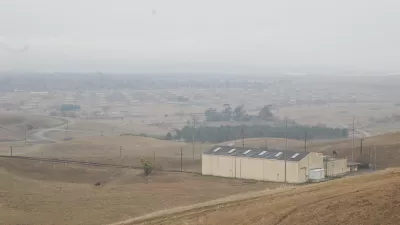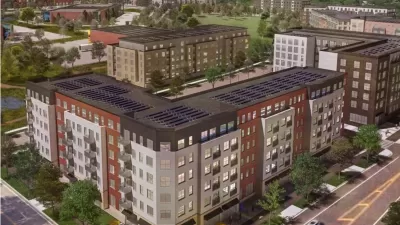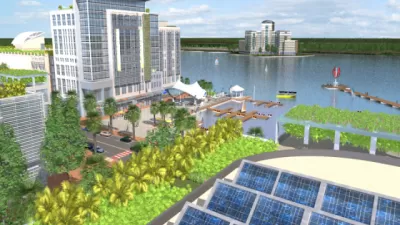The city of Concord, home to 130,000 but often neglected in the public consciousness of the San Francisco Bay Area, could set new standards for master planning practices.

John King provides a detailed update on one of the largest mega-development projects in Northern California right now—the $6 billion plan to convert a former naval weapons station to a master planned community including 13,000 homes, BART access, and a new approach to integrating a mix of uses into a new community.
"The potential canvas" for the project, writes King, "is the Concord Naval Weapons Station, a vast terrain dotted with trees and dozens of partially concealed ammunition bunkers."
"The emerging vision would place 13,000 housing units in structures ranging from multistory apartments above shaded colonnades to single-family homes on snug village greens. A transit corridor flanked by bicycle lanes would extend the length of the 3.4-mile-long site. Office buildings would cluster near the BART station at one end — parting to make room for a paseo-like footpath leading up to a ridgeline park."
While the project has been in works for the entire decade, a full plan and a draft environmental report are expected this winter, according to King, with a City Council vote on the project not likely for another year after that.
More than just providing details news coverage of the project, King also lends an assessment, as the San Francisco Chronicle's urban design critic, of the project's value to the city and the larger Bay Area. According to King, "in a region hobbled by the challenge of finding ways to add sizable amounts of housing in a manner that feels humane, the scenario in Concord offers heartening promise on a truly large scale."
In addition to the project's ability to deliver a large amount of housing in a supply constrained market, King also approves of how the planning and design details of the project are taking shape:
Plans at this stage often promise more than real life delivers. There’s no shortage of infill “placemaking” efforts in recent years that are hollow shells of their initial hype.
Nevertheless, it’s exciting to see a major firm focused on large-scale suburban futures — how to add density in a way that would take cues from its more settled surroundings while adding new layers to the scene.
FULL STORY: Concord weapons station has fraught history, but development concept has promise

Maui's Vacation Rental Debate Turns Ugly
Verbal attacks, misinformation campaigns and fistfights plague a high-stakes debate to convert thousands of vacation rentals into long-term housing.

Planetizen Federal Action Tracker
A weekly monitor of how Trump’s orders and actions are impacting planners and planning in America.

In Urban Planning, AI Prompting Could be the New Design Thinking
Creativity has long been key to great urban design. What if we see AI as our new creative partner?

Florida Seniors Face Rising Homelessness Risk
High housing costs are pushing more seniors, many of them on a fixed income, into homelessness.

Massachusetts Budget Helps Close MBTA Budget Gap
The budget signed by Gov. Maura Healey includes $470 million in MBTA funding for the next fiscal year.

Milwaukee Launches Vision Zero Plan
Seven years after the city signed its Complete Streets Policy, the city is doubling down on its efforts to eliminate traffic deaths.
Urban Design for Planners 1: Software Tools
This six-course series explores essential urban design concepts using open source software and equips planners with the tools they need to participate fully in the urban design process.
Planning for Universal Design
Learn the tools for implementing Universal Design in planning regulations.
Gallatin County Department of Planning & Community Development
Heyer Gruel & Associates PA
JM Goldson LLC
City of Camden Redevelopment Agency
City of Astoria
Transportation Research & Education Center (TREC) at Portland State University
Jefferson Parish Government
Camden Redevelopment Agency
City of Claremont





























